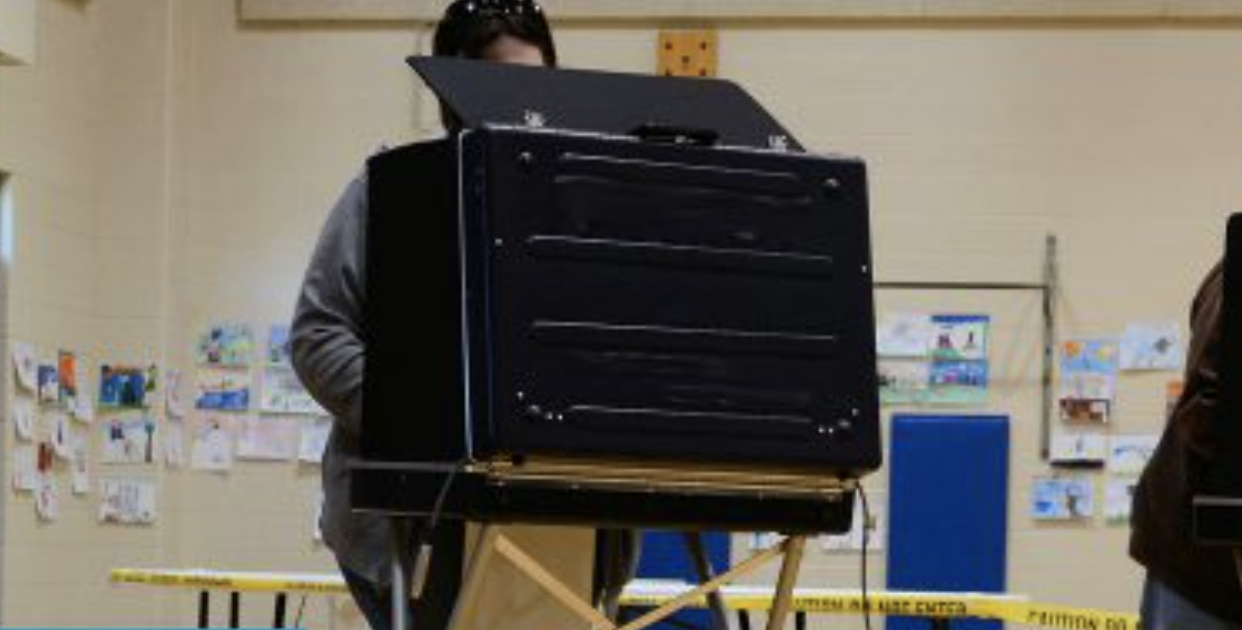Super Tuesday marked the first major round of primary contests following the first four states – Iowa, New Hampshire, Nevada, and South Carolina – which collectively allocated just 155 pledged delegates. Super Tuesday states award more pledged delegates than on any other day in the primary calendar (1,357, or 34 percent of all pledged delegates). Only candidates who (1) win 15 percent of the vote statewide and/or (2) meet the 15 percent viability threshold in a state’s congressional districts receive delegates, while nonviable candidates get none. Because Democratic primaries and caucuses are not winner-take-all – delegates are awarded proportionally – the margin of victory and how many total candidates pass the 15 percent threshold statewide and/or at the district level can make a huge difference when it comes to delegate allocation.
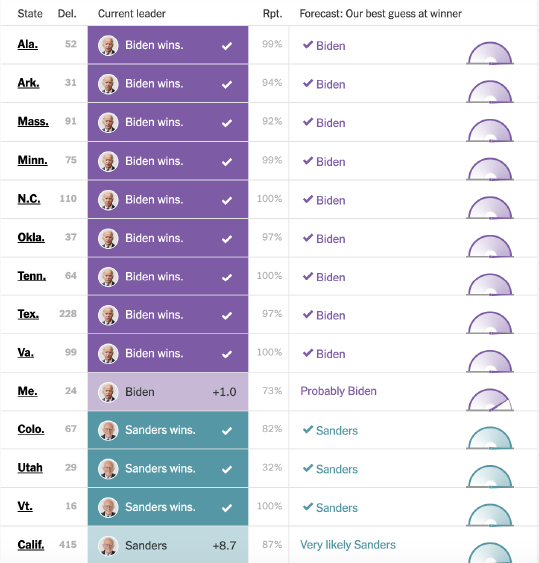
The latest results from the Super Tuesday contests show Joe Biden winning 9 states, including Alabama, Arkansas, North Carolina, Oklahoma, Tennessee, and Virginia by double-digit margins, and Massachusetts, Minnesota, and Texas by narrower single-digit margins. He is also favored to win Maine, but it remains too close to call. Bernie Sanders won Vermont, Colorado, and Utah by significant margins, and some outlets have projected he will win California (which is preliminary as votes are still being counted), though his final margin of victory will be narrower than other states he won. Michael Bloomberg also prevailed in the American Samoa Democratic caucuses and announced he would drop out and endorse Joe Biden on Wednesday morning.
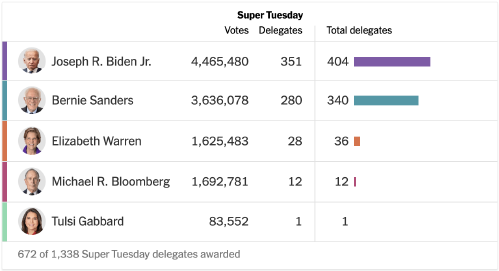
While it may take days or even weeks to determine the final delegate allocation from all Super Tuesday contests, it is widely expected that Biden will have won the most delegates across all 14 contests. The New York Times’ live estimate of delegate accumulation currently projects Biden to be ahead by approximately 80 delegates. Even without final results, Biden’s performance far exceeded expectations relative to pre-election public polling, driven by dominant performances in southern states similar to South Carolina, as well as unexpected victories in states such as Massachusetts, Minnesota, and Texas where Biden won large shares of late-deciding voters.
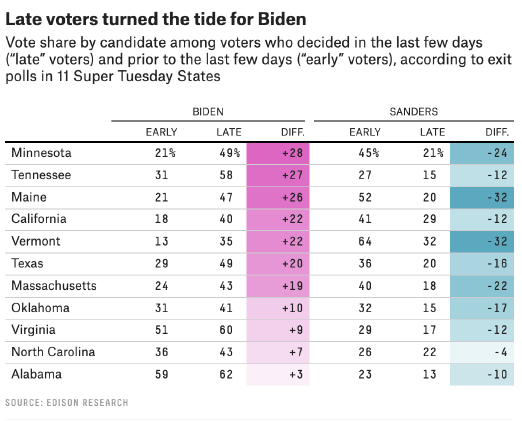
Virginia was the first state that indicated Biden may have a strong night. He was projected the winner of the state as soon as the polls closed based on exit polling alone. The day after South Carolina, FiveThirtyEight’s polling average showed Biden at 20.2 percent and Sanders at 25.3 percent in Virginia, suggesting a close race. However, candidates withdrawing from the race (Tom Steyer, Pete Buttigieg, Amy Klobuchar, and Bloomberg), endorsement from high-profile Democrats (in addition to Buttigieg and Klobuchar, he earned support from Beto O’Rourke, Harry Reid, and Bloomberg among others), and shifts in statewide polling moved at an exceedingly rapid pace between March 1 and Super Tuesday. Over this period, Biden’s average in the Virginia polls jumped from 20.2 to 39.9 on March 3, almost doubling the former vice president’s projected vote share. Based on results from Tuesday night, Biden’s sudden movement in the polls actually underestimated how well he would do in Virginia, where he won 53.3 percent of the vote. Almost all of Virginia’s 99 delegates will be allocated between Biden and Sanders, with the exception of Warren, who met the viability threshold in the 8th congressional district that holds 7 delegates total.
Joe Biden also won comfortably in southern Super Tuesday states, such as Alabama, Arkansas, North Carolina, Oklahoma, and Tennessee, similar to his overperformance in South Carolina:
- In Alabama, Biden overperformed by close to 20 points. FiveThirtyEight’s polling average had him at 40 percent going into Super Tuesday, but Biden won by a margin 46.6, receiving 63.2 percent of the vote with Sanders taking 16.6 percent.
- In Arkansas, Biden won by a margin of 18.1 points, getting 40.5 percent of the vote, followed by Sanders at 22.4 percent and Bloomberg at 16.7.
- In North Carolina, Biden won by 18.9 points, getting 43 percent with Sanders in a distant second at 24.1.
- Only Biden and Sanders became viable statewide in Oklahoma, with Biden at 38.7 percent and Sanders at 25.4 percent.
- In Tennessee, Biden won by a margin of 16.8, receiving 41.7 percent of the vote, Sanders at 24.9 percent, and Bloomberg became viable by netting 15.5 percent of the vote.
These results largely ran in line with expectations set by Biden’s clear win in South Carolina. But, per exit poll analysis, Biden overperformed his projections in every state except California, Utah, and Colorado. He also did unexpectedly well in Maine, going from a 22 percent polling average to winning 33.9 percent on Super Tuesday. FiveThirtyEight’s model predicted that Sanders would win 31 percent of the vote, which turned out to be extremely close to his actual result of 32.9 percent.
The closest race of the night took place in Texas, which was projected to be a virtual toss-up between Sanders and Biden. FiveThirtyEight’s model predicted that Biden would win 30 percent of the vote, Sanders 29 percent, Bloomberg 19 percent, and Warren 15 percent. Sanders was clearly ahead as the state reported early vote, but as election day precincts reported, Biden performed strongly there (Biden won 45 percent of late deciders according to exit poll data). With 95 percent of precincts reporting, Joe Biden won with 33.8 percent, Sanders placed second 29.9 percent, Bloomberg is third at 14.9 percent, and Warren placed fourth with 11.3 percent. Per the exit poll data, the state demonstrated the multi-racial coalitions of both Biden and Sanders: 58 percent of black voters supported Biden while Sanders won 55 percent of Asian voters.
Results from both Minnesota and Massachusetts stood out as examples of Biden performing well in states with electorates that are less racially diverse. Biden had no field offices in Minnesota and his polling average was at 10.7 percent on March 2. Klobuchar’s withdrawal and endorsement of Biden clearly caused the ground in Minnesota to shift rapidly. Biden’s polling average jumped to 18 percent on March 3 and he more than doubled that level of support at the ballot box, finishing with 38.6 percent; Sanders only overperformed his polling average by 4 points (finishing at 29.9 percent). Elizabeth Warren also hit statewide viability at 15.4 percent, ensuring she will earn some delegates from the state.
In Massachusetts, Joe Biden secured 33.1 percent of the vote ahead of Bernie Sanders at 26.4 and Elizabeth Warren at 21.4. Prior to Super Tuesday, FiveThirtyEight forecast that Sanders would win 29 percent of the vote, Warren 25 percent, and Biden 24 percent. Biden had little ground game in Massachusetts, with fewer field offices than Warren, Sanders, or Bloomberg. Biden overperformed his polling average by 9 points, doing well with older voters (47 percent) and moderate or conservative voters (46 percent) per exit polling. Previous polls suggested Warren could be competitive enough to win in her home state, but exit polling showed that while Warren has high favorability among white college educated women, she was unable to win over white men without a college degree in sufficient numbers. This gender dynamic may have made it difficult for her to consolidate broader support, even with a home-field advantage.
Overall, Biden won more states than Sanders on Tuesday night, but Sanders still won his home state of Vermont, and western states like Colorado, Utah, and California. Sanders won over half of all votes in Vermont (50.7 percent), while Biden finished second at 22 percent. He received 36.1 percent in Colorado while three other candidates also became viable in the state: Biden at 23.2 percent, Bloomberg at 21 percent, and Warren at 17.2 percent. Bloomberg advertised heavily in both Colorado and Texas, which helps put his slightly higher numbers there in context. In Utah, Sanders won 34.6 percent of the vote, with three other candidates clearing the viability threshold (Biden with 17.1 percent, Bloomberg with 16.9 percent, Warren with 15.4 percent).
In California – which will award the largest single delegate prize of the primary season – Sanders currently leads with 33.2 percent of votes cast, followed by Biden at 24.3 percent. Western states have been particularly strengths for Sanders given their large Hispanic populations and because many ballots had already been cast before Biden surged in endorsements and Super Tuesday polls. Sanders won 84 percent of Hispanic and Latino voters under the age of 30 in California. Since California’s ballots are still being counted (and will be for days and weeks to come), we Sanders’ lead could shrink despite being projected to be the statewide winner.
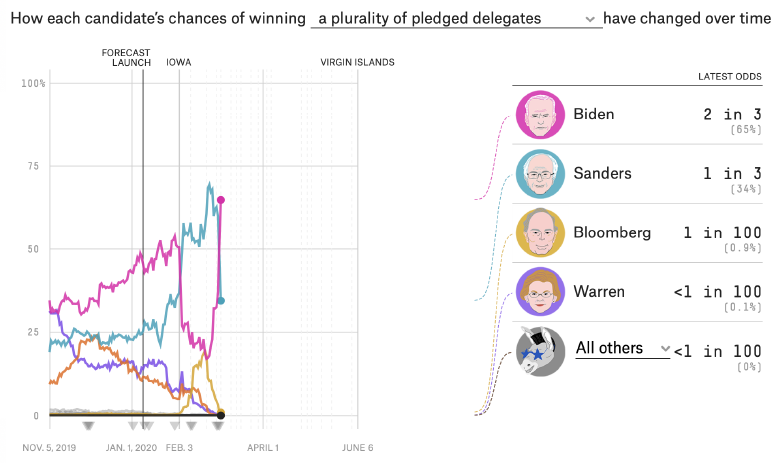
While it will take additional time to sort out delegate allocation between the candidates from the Super Tuesday contests, we do know projections right before March 3 showed a big shift toward Biden with a 31 percent to win a majority of pledged delegates, and 65 percent to win a plurality. Sanders was rated second most likely to win outright at 8 percent (34 percent likelihood to win a plurality), but the FiveThirtyEight model was at that point still forecasting a substantial degree of uncertainty (61 percent no one gets a majority). It is possible that these predictions will shift substantially given Biden’s overperformance across most Super Tuesday states. But it remains an open question as to whether or not either candidate can secure a majority in the delegate race and there may still be a high degree of uncertainty on this even after final results come in from California.
Featured polls
[featured_polls]
